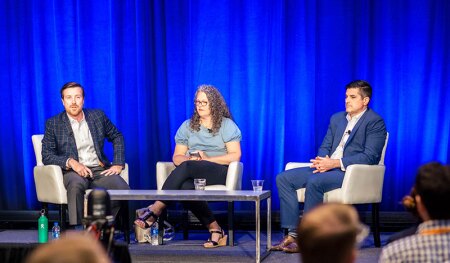A coordinated regional commuter rail system envisioned for the national capital region could unlock opportunities and increase equity for residents and neighborhoods, panelists asserted during a session Thursday at the 2022 ULI Spring Meeting in San Diego.
The region from Baltimore to Richmond constitutes the nation’s third-largest economy, but it is neither fully equitable nor inclusive, said moderator Joe McAndrew, vice president, transportation, of the Greater Washington Partnership, an alliance of local business leaders that is backing an ambitious commuter rail plan. Equitable growth calls for a successful transportation system, he said. The panel, “Developing More Inclusive and Equitable Communities through Regional Transit,” discussed that proposal.
The region’s crowded highways are not the answer, said Katherine Youngbluth, director of planning for the Virginia Passenger Rail Authority. “We could invest billions of dollars in the interstates and never realize any benefit in reducing congestion,” she said.
The Partnership’s rail proposal, unveiled in March 2021, envisions smooth connections between Maryland and Virginia rail systems that now operate separately. They both bring commuters into the District of Columbia and terminate there. Instead, the proposal envisions trains running just 15 minutes apart, seven days a week, providing one-seat rides along the entire corridor. It calls for $23 billion in investment over 25 years. Beyond simply connecting the systems—itself a feat of coordination—the plan calls for upgrading aging infrastructure bottlenecks.
Plans are underway to address of those bottlenecks, the Long Bridge that crosses the Potomac River from Virginia to D.C., carrying just two train tracks. The upgrade will add two more tracks and is projected to cost $4 billion. “It will unlock that pinch point” when completed in 2030, Youngbluth said. “We can unlock 15-minute head times and weekend service.” The other big infrastructure project, upgrades to a Civil War–era tunnel in Baltimore, is further in the future.
If the regional system comes to pass, it would expand possibilities for employers and employees, said Jay Corbalis, vice president at JBG SMITH Properties, developer of National Landing, a Northern Virginia neighborhood that will house Amazon’s second headquarters, as well as smaller businesses. The tech giant promises to employ more than 25,000 people there. A regional rail system could bring workers from throughout Maryland to the Virginia site, Corbalis said, putting an additional 765,000 residents within a one-hour commute of National Landing. It also could let workers at National Landing live somewhere more affordable, putting an additional 100,000 moderately priced homes within commuting distance, he said.
Such opportunities are especially important to increase equity for Black and brown people, said Dannielle Glaros, a county council member from Prince George’s County in suburban Maryland. Hers is one of the nation’s most affluent majority-Black counties, but its wealth lags the rest of the region. The region can only grow economically and equitably if talent can get to jobs, she said. Now, Maryland’s commuter rail, as well as Amtrak, runs through her district, but all the train lines end in D.C. A coordinated system would be “the opportunity to really unlock this wealth gap. We believe our GDP in the region can grow dramatically,” she said.
The upgraded regional plan also would benefit neighborhoods surrounding stations—important from an equity standpoint, said David Zaidan, area practice leader for transportation and planning at Gensler, which studied effects on riders and stations. Additional tracks and additional service transform some stations that are now little used into attractive amenities.
During the question session, an audience member asked about the political will needed to carry though with such ambitious plans. The panelists agreed that is key, and said there has been evidence in both Virginia and Maryland of bipartisan backing. These projects take a very long time, Zaidan said. “There needs to be continued political support.”





